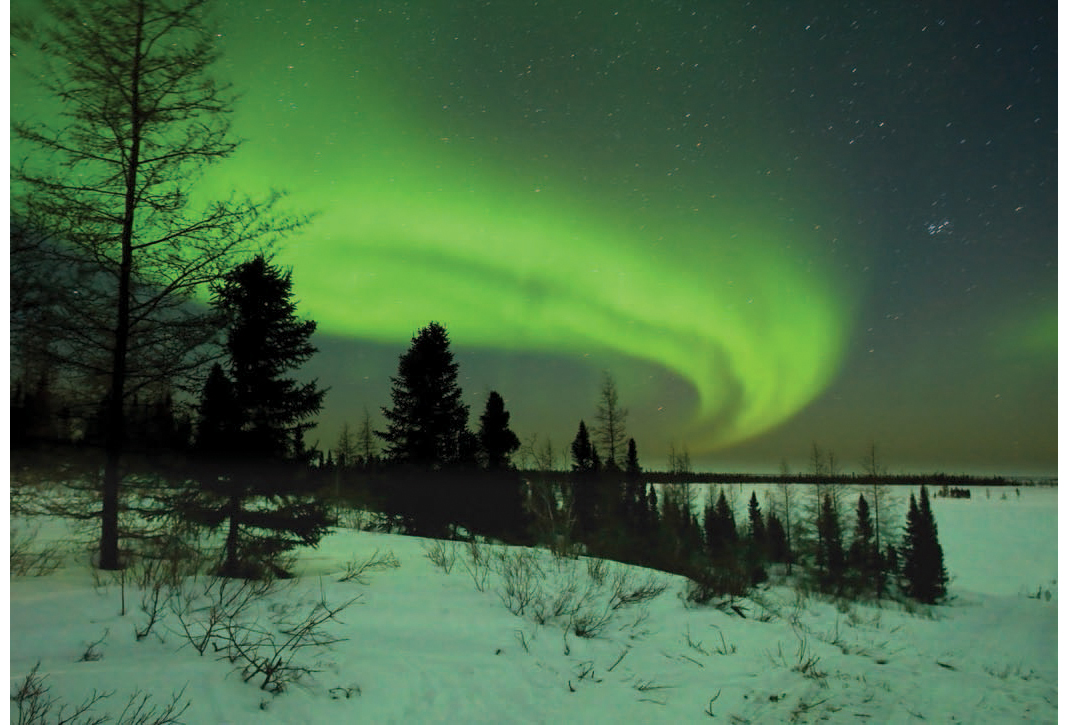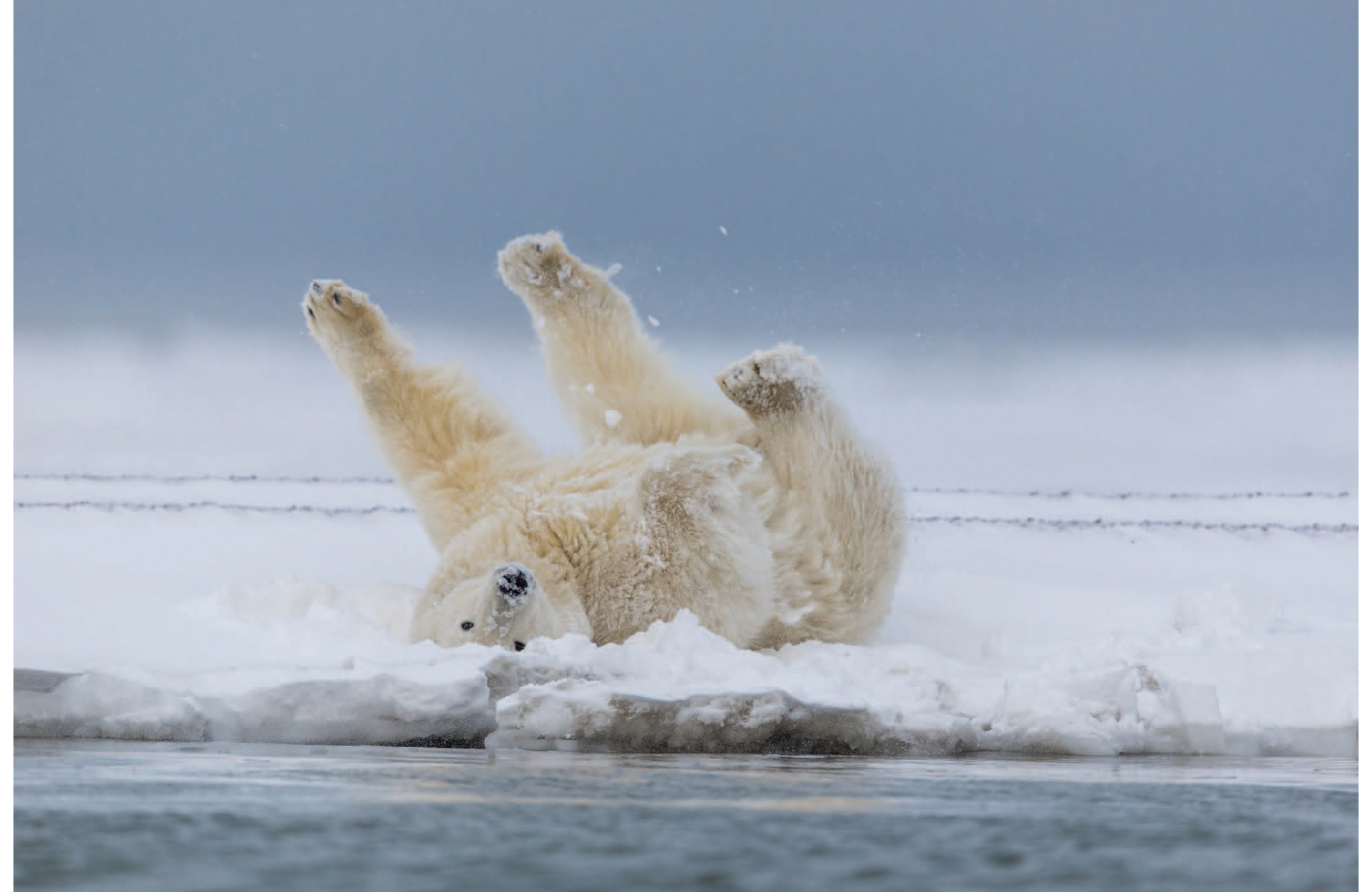The Polar Bear’s world is one of cold and ice, with temperatures that may drop below -50 degrees Fahrenheit in winter, under skies that may pulsate magically with displays of the northern lights. In winter, for bears living high above the Arctic Circle, their world may be one of perpetual gloom, dimly lit by the stars and moon and by the faint glow along the southern horizon from a land where the sun still shines.
Ice is the key to the Polar Bear’s world. This is a challenging landscape where few humans have learned to live, but one where the adaptations of the Polar Bear have allowed it to thrive, at least until relatively recently. The Polar Bear’s thick fur coat insulates it from the cold, and the bear’s ability to swim long distances in frigid seas enables the Polar Bear to reach land or pack ice, or to hunt from ice floe to floe for resting seals.
ON THE EDGE
Photo: Tom Wester
Standing on a platform of rocks iced in hoar frost and snow, a male Polar Bear peers out toward Hudson Bay, waiting for freeze-up and perhaps his first meal in at least three months.

NIGHT FALLS AND HUNTING BEGINS
Photo: Hugh Rose/hughrosephotography.com
In some portions of the Polar Bear’s range, when the sun sets, darkness remains for weeks or months. Temperatures plummet, but seal hunting actually is easier at this time than during the summer months, when much of the ice melts. During this long polar night, Polar Bears hunt the ice for seals that are often restricted to a series of breathing holes and are not free to roam.

LAND OF PERPETUAL NIGHT
Photo: Tom Wester
The Arctic is often called the Land of the Midnight Sun, and indeed in summer, the sun may not set for several weeks. Conversely, the highest latitudes of the Arctic could be called the Land of Perpetual Night, as the sun never rises above the horizon during winter. On polar nights, however, the moon, stars, and refracted sunlight on the distant southern horizon provide some light, allowing Polar Bears to remain active in this land of darkness.

THE NORTHERN LIGHTS
Photo: Katherine Pierce/CureUs Designs
During the Arctic night, the sky may shimmer with ethereal colors, ribbons of light that dance across the sky. This is the aurora borealis, the northern lights, a phenomenon triggered by the solar wind, where charged particles from the sun collide with gas molecules in the upper reaches of Earth’s atmosphere. One wonders if the Polar Bear appreciates these spectacles.

CONGREGATIONS
Photo: Hugh Rose/hughrosephotography.com
Along the coast of northern Alaska, Polar Bears may gather in surprising numbers. Polar Bears are normally thought of as solitary animals, but as winter nears and bears move to the coasts awaiting freeze-up, large numbers can be seen together. Surprisingly, the bears often interact, with cubs playing or young males wrestling as they await the cold.

FREEZE-UP
Photo: Steve Metildi
During the summer in Churchill, Manitoba, Polar Bears are marooned on land for months. With the arrival of winter and cold weather, Hudson Bay may freeze in just a few days. When it does, virtually every bear disappears, as all head out to the ice and for their first meal in months.

FAST ICE
Some of the best hunting occurs on the “fast ice,” named because the ice is attached to the land or glaciers and is held “fast” or stable. Ringed Seals, the Polar Bear’s favorite food, maintain breathing holes in the fast ice, providing sure locations for bears to hunt, as they wait for a seal to appear.

PACK ICE
Polar Bears regularly patrol the floating pack ice, where Bearded Seals often haul out for a rest or a sleep. Pack ice floats with the wind and the ocean currents, and enormous but disjointed sheets of ice may drift for hundreds of miles. Still, in this transient landscape, Polar Bears maintain home ranges, and will return to the same region year after year despite the drifting that may occur.

BREAK UP
Photos: Adam Rheborg
As summer advances, the fast ice begins to melt, sometimes breaking off into large sheets that may, eventually, drift far from land and become a part of the pack ice. As global temperatures rise and ice cover declines, greater and greater areas of open water result. Bears, hunting the pack ice, often have to swim great distances from one ice floe to another.


ICE FLOES
A landscape with equal amounts of open water and ice floes provides ample habitat for Polar Bears, as Bearded Seals are common in this landscape. While this Polar Bear appears to be sleeping, appearances are deceiving. Should a seal surface nearby, the bear will begin a hunt.

ON THE EDGE
When the fast ice begins to break up, Polar Bears have two areas for pursuing seals. Closer to shore, where the ice is still solid, Ringed Seals maintain their breathing holes in the ice, while at the interface of ice and sea, seals may haul out to rest or to sleep. In either case, the most productive hunting is over the continental shelf where the sea is the shallowest and access to food greatest for the seals.

BROKEN GLASS
Photo: Adam Rheborg
A Polar Bear negotiates a route across shards of ice that remind one of a broken window pane. The Velcro-like pads and sharp claws of the Polar Bear’s feet assist in traction as the bear walks across what, to us humans, would be an impossible landscape to negotiate.

DRIFTING
Since pack ice moves with the ocean currents and wind, a Polar Bear may travel hundreds of miles from its original location. Maintaining a home range, Polar Bears will eventually return to the approximate location where they began their journey. While there are many theories, no one really knows how the bears navigate through a landscape often devoid of landmarks.

STAYING DRY
Photo: Adam Rheborg
While Polar Bears are accomplished swimmers, bears often avoid getting wet by jumping small gaps or taking a circuitous route. Mothers with cubs are especially prone to avoid water, as cubs, with their smaller total body mass, could suffer hypothermia in the ice-cold water. When swimming cannot be avoided, small cubs often ride on their mother’s back to stay partially dry.

COLLAPSE
Each year, the fast ice melts earlier in the spring, and travel across the ice becomes more difficult as the ice thins. Bears will splay themselves like a starfish to disperse their weight when crossing thin ice, although sometimes they still crash through. Repeated dunks and the effort to climb back onto the ice burns up valuable energy the bears will need during the lean months of late summer and fall.

FAMILY SWIM
Photo: Hugh Rose/hughrosephotography.com
When necessary, Polar Bears can swim long distances, nearly 100 miles in some cases. The Arctic seas are often calm, but storms can arise, generating waves that make any long swim arduous and dangerous. While an adult bear may survive a long swim, or one in turbulent waters, cubs probably will not. As the polar ice shrinks, storms and waves are expected to increase, and with it, one could expect Polar Bear numbers to suffer.

DUNKING FOR SEALS
We watched this Polar Bear for hours as it dug into the snow and ice, sometimes dipping into open water or diving in and swimming underwater for several yards before resurfacing. Such efforts expend a lot of energy, and although the bear didn’t look thin, we wondered if it was indeed hungry and this prompted its behavior.

PROTECTED SPECIES
The Polar Bear is protected in the U.S. under the Marine Mammal Act, and one can understand why it is considered a marine mammal after watching a bear swim and dive through the cold Arctic seas. Bears generally hold their breath for less than one minute, still quite a feat in 30-degree water that would literally take the breath away from a swimming human!

THE BIG SHAKE
Like a shaggy dog, a Polar Bear gives a vigorous shake that ripples down its body, spewing water everywhere in the first step in drying off.

BACK RUB
Polar Bears are fastidious in their cleanliness, and scientists who tranquilize and tag these white bears report they are nearly odorless. Clean fur is essential to maintain the loft in their fur for the insulation necessary in a climate that can drop to -50 degrees Fahrenheit.

BELLY RUB
Snow acts as a great drying agent, and a Polar Bear will slide along on its belly, propelled by the claws of its hind legs, sometimes traveling a dozen yards or more before rolling to its side or back and rubbing itself dry.

SNOW CAKES
Photo: Hugh Rose/hughrosephotography.com
Snow clings in bunches to the wet fur of a Polar Bear, acting as a drying agent as soon as the bear shakes. These shakes and rolls are always comical to watch and provide tourists and photographers wonderful opportunities for funny poses.

FLYING SNOW
Photo: Katherine Pierce/CureUs Designs
A Polar Bear awakes after a snowfall, shaking himself dry. Snow is actually a good source of insulation, and pregnant Polar Bears sometimes den on open slopes where accumulating snow will eventually create the foundations for her den.

SNOW MOUND OR BEAR?
Photo: Adam Rheborg
A sleeping bear, covered by fresh snow, is indistinguishable from other snow mounds; a frustrating fact for tourist guides intent on spotting bears! Bears marooned on land may spend most of their time sleeping, and even those hunting the pack ice may sleep for hours or days, snugly curled in a furry ball.

LEAN TIMES
Once the fast ice melts, Polar Bears either move onto the pack ice, if it is within range of a long walk or swim, or remain land-locked where meals are meager, few, and far between. The next substantial meal may not occur for four months or longer, when winter returns and, with it, the ice.

“THIS FAT BEAR, STRANDED ON AN ALASKAN BEACH UNTIL THE WINTER SEA ICE RETURNS, IS LIKELY TO LOSE AT LEAST A THIRD OF ITS BODY WEIGHT BY THEN.”
WIDE BODY
Photo: Hugh Rose/hughrosephotography.com
Luckily, Polar Bears don’t travel in commercial jets, as this bear’s huge girth would overflow any seat! This fat bear, stranded on an Alaskan beach until the winter sea ice returns, is likely to lose at least a third of its body weight by then.

DANGEROUS TIMES
Photo: Hugh Rose/hughrosephotography.com Thin bears, marooned on land for several months, may face starvation. This is especially true for cubs that lack the mass of a much larger bear. During these lean months, Polar Bears will go into what is termed “walking hibernation,” as their metabolism slows and conserves energy, but without requiring the bear to go into a deep sleep. Bears can enter or exit this state as food availability changes.

“THIN BEARS, MAROONED ON LAND FOR SEVERAL MONTHS, MAY FACE STARVATION.”